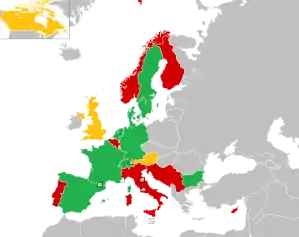| Eurovision Young Dancers 1991 | |
|---|---|
 | |
| Dates | |
| Final | 5 June 1991 |
| Host | |
| Venue | Helsinki City Theatre, Helsinki, Finland |
| Presenter(s) |
|
| Directed by | Izan Lewenstam |
| Executive supervisor | Frank Naef |
| Executive producer | Aarno Cronvall |
| Host broadcaster | Yleisradio (YLE) |
| Website | youngdancers |
| Participants | |
| Number of entries | 15 |
| Debuting countries | |
| Returning countries | None |
| Non-returning countries | |
Participation map
| |
| Vote | |
| Voting system | A professional jury chose the top 3 participants. |
| Winning dancers | Amaya Iglesias |
The Eurovision Young Dancers 1991 was the fourth edition of the Eurovision Young Dancers, held at the Helsinki City Theatre in Helsinki, Finland on 5 June 1991.[1] Organised by the European Broadcasting Union (EBU) and host broadcaster Yleisradio (YLE), dancers from eight countries participated in the televised final. A total of fifteen countries took part in the competition. Bulgaria made their début (making this the first Eurovision event to feature a former Warsaw Pact country ahead of the 1994 Eurovision Song Contest), while Austria, Canada and United Kingdom chose not to send an entry.[1] However, the Austrian broadcaster ÖRF and the Canadian CBC broadcast the event.
Each country could send one or two dancers, male or female, who could perform one or two dances.
The non-qualified countries were Belgium, Cyprus, Finland, Italy, Norway, Portugal and Yugoslavia. Amaya Iglesias of Spain won the contest, with France and Denmark placing second and third respectively.[2]
Location

Helsinki City Theatre, was the host venue for the 1991 edition of the Eurovision Young Dancers.[1]
Format
The format consists of dancers who are non-professional and between the ages of 16–21, competing in a performance of dance routines of their choice, which they have prepared in advance of the competition. All of the acts then take part in a choreographed group dance during 'Young Dancers Week'.[3]
Jury members of a professional aspect and representing the elements of ballet, contemporary, and modern dancing styles, score each of the competing individual and group dance routines. The overall winner upon completion of the final dances is chosen by the professional jury members.[3]
During the interval a documentary by Finnish journalist Eila-Maija Mirolybov about the early stages of the competition and the dancers who did not reach the final was broadcast.[1]
Results
Preliminary round
A total of fifteen countries took part in the preliminary round of the 1991 contest, of which eight qualified to the televised grand final. The following countries failed to qualify.[1]
| Country | Participant | Dance | Choreographer |
|---|---|---|---|
| Alen Bottaini | Grand pas classique | V. Gsovsky | |
| Vanessa Eertmans | Concerto for Harpsichord and Strings in D minor | D. Sonnenbluck | |
| Titta-Tuulia Karhunen and Pasi Sinisalo | "Le Corsaire" | M. Petipa | |
| Sonia Lima | "Don Quixote" | M. Petipa | |
| Ingrid Trøite Lorentzen | "Don Quixote" | M. Petipa | |
| Hélène O'Keefe | "Glorianna, Hymne à la femme" | N. Mújaszí | |
| Ana Pavlovic | "Coppelia" | K. Damjanov |
Final
Awards were given to the top three countries. The table below highlights these using gold, silver, and bronze. The placing results of the remaining participants is unknown and never made public by the European Broadcasting Union.[2]
| Place | Country | Participant | Dance | Choreographer |
|---|---|---|---|---|
| 1 | Amaya Iglesias | Variations from "La Grisi" | L. de Ávila | |
| 2 | Emmanuel Thibault | "La Sylphide" | F. Taglioni | |
| 3 | Johan Kobborg | "La Sylphide" | A. Bournonville | |
| – | Diliana Nikiforova | "The Sleeping Beauty" | M. Petipa | |
| – | Celia Volk | "Le Corsaire" | M. Petipa | |
| – | Boris de Leeuw | "Prelude to a Kiss" | P. de Ruiter | |
| – | Kim Saveus | "Le Corsaire" | M. Petipa | |
| – | Sarah Locher | "The Sleeping Beauty" | M. Petipa |
Jury members
The jury members consisted of the following:[1]
 Finland – Jorma Uotinen (Head of Jury)
Finland – Jorma Uotinen (Head of Jury) France – Josette Amiel
France – Josette Amiel Denmark – Frank Andersen
Denmark – Frank Andersen Romania/
Romania/ France – Gigi Gheorghe Caciuleanu
France – Gigi Gheorghe Caciuleanu Germany – Peter Van Dyk
Germany – Peter Van Dyk France – André-Philippe Hersin
France – André-Philippe Hersin.svg.png.webp) Switzerland – Heinz Spoerli
Switzerland – Heinz Spoerli Sweden – Gösta Svalberg
Sweden – Gösta Svalberg Spain – Víctor Ullate
Spain – Víctor Ullate
Broadcasting
The 1991 Young Dancers competition was broadcast in 17 countries including Austria and Canada.[4]
| Country | Broadcaster(s) |
|---|---|
| RTBF | |
| BNT | |
| CyBC | |
| DR | |
| Yle | |
| France 3 | |
| ZDF | |
| Rai | |
| NOS | |
| NRK | |
| RTP | |
| TVE | |
| SVT1 | |
| SRG SSR | |
| TSR | |
| JRT | |
| Country | Broadcaster |
|---|---|
| ORF | |
| CBC |
See also
References
- 1 2 3 4 5 6 "Eurovision Young Dancers 1991: About the show". European Broadcasting Union. Retrieved 5 October 2014.
- 1 2 "Eurovision Young Dancers 1991: Participants". youngmusicians.tv. European Broadcasting Union. Retrieved 5 October 2014.
- 1 2 "Eurovision Young Dancers – Format". youngdancers.tv. European Broadcasting Union. Archived from the original on 11 February 2015. Retrieved 8 March 2015.
- ↑ "Eurovision Young Dancers 1991". Issuu. Retrieved 2 May 2018.
